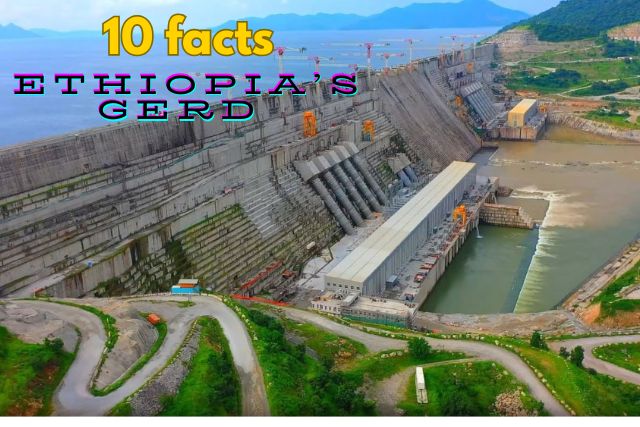
Ethiopias GERD
Ethiopia Officially Inaugurates Africa’s Largest Hydroelectric Dam. 10 Interesting Facts About the Grand Ethiopian Renaissance Dam (GERD)
Addis Ababa, Ethiopia – Tuesday, September 9, 2025 Ethiopia officially inaugurated the Grand Ethiopian Renaissance Dam (GERD), Africa’s largest hydroelectric power project, marking a historic milestone for the nation and the continent.
The $5 billion (£3.7bn) megastructure, located on the Blue Nile in the Benishangul-Gumuz region, is designed to generate over 5,150 megawatts (MW) of electricity. Which is enough to power millions of homes and industries.
The inauguration ceremony was nothing short of symbolic. Beneath a canopy shaped like the map of Ethiopia and decorated in the national flag’s colors, Prime Minister Abiy Ahmed addressed dignitaries and citizens.

“Ethiopia built the dam to prosper, to electrify the entire region, and to change the history of black people. It is absolutely not to harm its brothers,” Abiy declared, referring to tensions with downstream Egypt and Sudan.
The project, entirely funded by Ethiopians at home and abroad through government bonds and contributions, is widely seen as a continental symbol of self-reliance. It positions Ethiopia, Africa’s second most populous nation with over 120 million people as a rising energy hub.
But the GERD is not just about electricity. It is a story of ambition, resilience, and regional politics.
Below, we explore interesting facts about Ethiopia’s new dam that make it one of the most talked-about infrastructure projects in the world today.
GERD is One of the Top 20 Largest Hydroelectric Dams in the World
The Grand Ethiopian Renaissance Dam has a generation capacity of 5,150 MW, placing it among the world’s top 20 biggest hydroelectric dams. That’s about one-quarter of the capacity of China’s Three Gorges Dam, the largest hydroelectric project globally.

At 170 meters (558 feet) tall and spanning 1.8 kilometers, the dam has been designed not only for Ethiopia’s domestic energy needs but also for regional electricity exports. Prime Minister Abiy Ahmed has already signaled readiness to supply surplus power to neighboring countries, boosting East Africa’s integration and industrialization efforts.
The Project Took Over a Decade to Build Without Foreign Loans
Construction of the GERD began in 2011 and has faced delays due to funding challenges, regional disputes, and technical hurdles. What makes the dam unique is that it was funded entirely by Ethiopians, without foreign credit or loans.
Citizens at home and in the diaspora bought government bonds, reflecting a high level of trust in government and commitment to national progress. This financing model has strengthened Ethiopia’s sovereignty, avoiding dependency on external lenders and proving that African nations can mobilize internal resources for megaprojects.
It Could Transform Regional Energy Trade
Ethiopia’s hydropower potential is enormous, and the GERD is the centerpiece. According to President William Ruto of Kenya, who attended the inauguration, Kenya is ready to sign a power purchase agreement with Ethiopia. The deal would see Ethiopia exporting surplus electricity to Kenya to power industries, ICT hubs, manufacturing plants, and agro-processing centers.
This could significantly reduce Kenya’s reliance on thermal power, cut energy costs, and strengthen the competitiveness of East African economies. Tanzania and Sudan are also expected to benefit, making the GERD a regional growth catalyst.
The Dam Deepens the Rift with Egypt and Sudan
Despite its benefits, the GERD remains controversial. Egypt, which relies on the Nile for over 90% of its water supply, fears that Ethiopia’s filling and operation of the dam will reduce water flows downstream.
Egypt’s concerns are rooted in historical treaties — the 1929 Anglo-Egyptian Treaty and the 1959 Nile Waters Agreement — which gave Cairo significant control over the Nile waters. Ethiopia was not part of these colonial-era agreements and has long rejected them as unjust.
Tensions have at times threatened to escalate into conflict, but Ethiopia insists the dam is for development, not harm.
Kenya, which reaffirmed its support during the inauguration, has urged all Nile Basin countries to pursue dialogue and compromise.
The GERD is a Symbol of African Self-Reliance
Beyond energy, the GERD stands as a symbol of African ambition. Prime Minister Abiy Ahmed emphasized that the project demonstrates Africa’s ability to marshal its own resources and chart its own destiny.

The inauguration was attended by several African leaders, including:
- President William Ruto (Kenya)
- President Hassan Sheikh Mohamud (Somalia)
- President Salva Kiir Mayardit (South Sudan)
- President Ismail Omar Guelleh (Djibouti)
- Prime Minister Mia Amor Mottley (Barbados)
- Prime Minister Russell Mmiso Dlamini (Eswatini)
- AU Commission Chair Mahmoud Ali Youssouf
Their presence highlighted the GERD as a pan-African achievement, celebrated not just in Ethiopia but across the continent.
A Strategic Inauguration
Interestingly, Prime Minister Abiy Ahmed timed the GERD’s inauguration to coincide with the Africa Climate Summit 2, currently being held in Addis Ababa.
This timing underscored Ethiopia’s push for international legitimacy while showcasing Africa’s commitment to renewable energy. Especially, at a time when the world is under pressure to cut carbon emissions.
While Uganda’s President Yoweri Museveni, an ally of Egypt, skipped the ceremony, President Ruto’s strong endorsement placed Kenya firmly on Ethiopia’s side.
Analysts say this alignment could shape East Africa’s diplomatic and energy landscape in the years to come.
What GERD Means for Ethiopia and Africa
For Ethiopia, the GERD promises to electrify millions, drive industrialization, and reduce reliance on imported fuels. For Africa, it represents progress toward energy independence and sustainable growth.
Yet challenges remain. Balancing the energy needs of Ethiopia with the water security concerns of Egypt and Sudan requires careful diplomacy. Experts warn that unless a trilateral agreement is reached, tensions could undermine the very regional cooperation Ethiopia hopes to foster.
Trending Social Media Reactions to Ethiopia’s New Dam
The inauguration of the Grand Ethiopian Renaissance Dam (GERD) sparked a wave of reactions online, with leaders, analysts, and citizens weighing in on what the project means for Ethiopia, Africa, and the Nile Basin.
- President William Ruto (Kenya):
“Kenya is ready to sign a power purchase agreement with Ethiopia to offtake surplus electricity to power our industries, ICT hubs, manufacturing, and agro-processing. The GERD is a symbol of Africa’s ability to mobilize its own resources.” - Duncan Kibwage Makori (Kenya political analyst):
“President Ruto attending the inauguration of Ethiopia’s Grand Renaissance Dam is both an opportunity and a risk. Kenya stands to benefit from surplus electricity, but it is also now deeply tied to the politics of the Nile.” - Regional Commentators on X (formerly Twitter):
- “Ethiopia has pulled off a $5 billion mega dam without foreign loans. A lesson in self-reliance for Africa.”
- “Egypt’s absence speaks volumes. The Nile dispute will not vanish overnight, but the GERD is now a reality.”
- “Proud of Ethiopia! This project is Africa saying we can do it ourselves.”
These reactions highlight both the pride and tension surrounding GERD. On one hand, it’s celebrated as an African achievement; on the other, it remains a focal point in regional geopolitics.
Additional Interesting Facts About GERD

Beyond the five main highlights, here are more fascinating facts about Ethiopia’s new dam:
1. It Can Produce the Equivalent of Three Nuclear Power Plants
At full capacity (5,150 MW), the GERD produces about the same amount of electricity as three medium-sized nuclear plants, making it one of the most significant renewable energy projects in the world.
2. Ethiopia Aims to Export Power to at Least Six Countries
Besides Kenya, Ethiopia is in talks with Sudan, Djibouti, Tanzania, Eritrea, and South Sudan for electricity export deals. This could transform Ethiopia into a regional energy hub.
3. GERD Boosts Trust in Government Financing
The project was financed through public contributions, bonds, and diaspora support, boosting citizens’ trust in government institutions. It’s rare for such a mega-project to be achieved without external donors, making it a case study in domestic financing.
4. Environmental and Climate Benefits
Unlike coal or oil plants, GERD runs on clean hydropower, aligning with Africa’s climate action agenda. By producing renewable energy, it reduces greenhouse gas emissions and supports Africa’s green growth goals.
5. A Decade of Geopolitical Tension
Since 2011, the GERD has been at the heart of diplomatic disputes, particularly with Egypt and Sudan. Multiple rounds of talks have stalled, with Egypt warning of potential threats to its water supply. The dam is as much a geopolitical story as it is an engineering one.
Conclusion
The official inauguration of the Grand Ethiopian Renaissance Dam (GERD) is a landmark in Africa’s modern history. At a cost of $5 billion and built entirely through the sacrifices of its people, it is more than just a dam. Thus, it is a monument to resilience, sovereignty, and progress.
With a capacity of 5,150 MW, it stands as the largest hydroelectric project in Africa, reshaping not only Ethiopia’s energy future but also the geopolitical landscape of the Nile Basin.
Whether celebrated as a symbol of African pride or scrutinized as a source of tension, one thing is certain: the GERD has already changed the story of Africa’s development.





